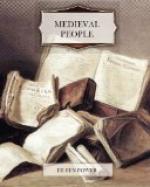Notes on Illustrations
PLATE I. Bodo at his work
From an eleventh-century Anglo-Saxon calendar in the British Museum (MS. Tit., B.V., pt. I), showing the occupations of Bodo, or of his masters, for each month of the year. The months illustrated are January (ploughing with oxen), March (breaking clods in a storm), August (reaping), and December (threshing and winnowing). The other pictures represent February (pruning), April (Bodo’s masters feasting), May (keeping sheep), June (mowing), July (woodcutting), September (Bodo’s masters boar-hunting), October (Bodo’s masters hawking), and November (making a bonfire).
PLATE II. Embarkation of the Polos at Venice
From the magnificent MS. of Marco Polo’s book, written early in the fifteenth century and now preserved at the Bodleian Library, Oxford (MS. no. 264, f. 218). The artist gives an admirable view of medieval Venice, with the Piazetta to the left, and the Polos embarking on a rowing boat to go on board their ship. In the foreground are depicted (after the medieval fashion of showing several scenes of a story in the same picture) some of the strange lands through which they passed. Note the Venetian trading ships.
PLATE III. Part of a landscape roll by Chao Meng-fu
This very beautiful scene is taken from a roll painted by Chao Meng-fu in 1309 in the style of Wang Wei, a poet and artist of the T’ang dynasty (A.D. 699-759). A fine description of it is given by Mr Laurence Binyon: ’In the British Museum collection is a long roll, over seventeen feet long, painted almost entirely in blues and greens on the usual warm brown silk.... It is one continuous landscape, in which the scenes melt into one another. Such rolls are not meant to be exhibited or looked at all at once, but enjoyed in small portions at a time, as the painting is slowly unrolled and the part already seen rolled up again. No small mastery is requisite, as may be imagined, to contrive that wherever the spectator pauses an harmonious composition is presented. One has the sensation, as the roll unfolds, of passing through a delectable country. In the foreground water winds, narrowing and expanding, among verdant knolls and lawns, joined here and there by little wooden bridges; and the water is fed by torrents that plunge down among pine-woods from crags of fantastic form, glowing with hues of lapis-lazuli and jade; under towering peaks are luxuriant valleys, groves with glimpses of scattered deer, walled parks, clumps of delicate bamboo, and the distant roofs of some nestling village. Here and there is a pavilion by the water in which poet or sage sits contemplating the beauty round him. These happy and romantic scenes yield at last to promontory and reed-bed on the borders of a bay where a fisherman’s boat is rocking on the swell. It is possible that a philosophic idea is intended to be suggested—the passage of the soul through the pleasant delights of




